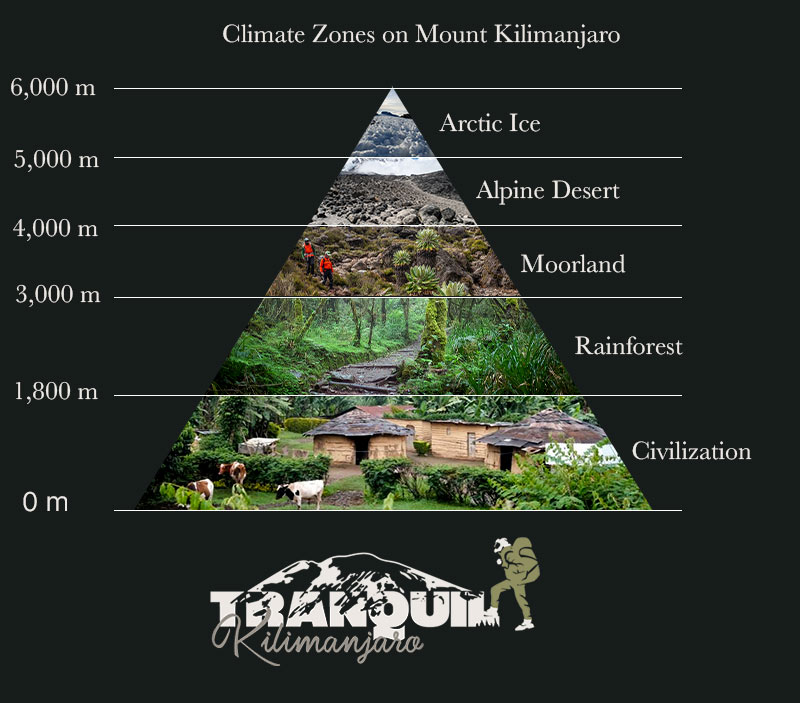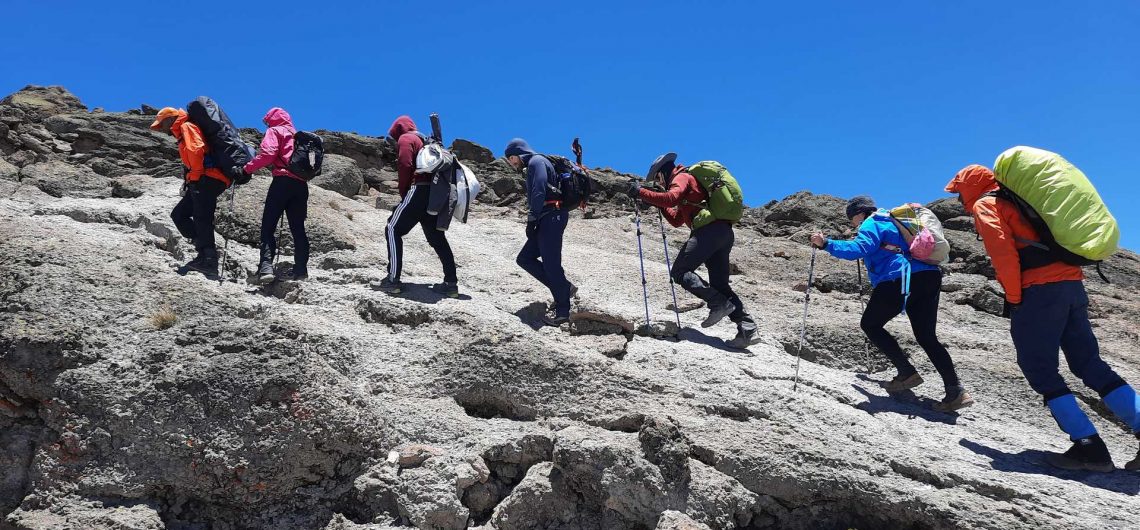This comprehensive guide to climbing Mount Kilimanjaro is for everyone who wants to tackle this incredible peak. Have you ever wondered why this mountain is so well-known? What are the most important things to know before beginning this life-defining challenge? Why do so many people like to climb this mountain? This guide provides a detailed list of critical suggestions to consider while climbing this peak.
Mount Kilimanjaro, sometimes known as “The Roof of Africa,” is Africa’s tallest peak and is covered with snow. It’s also the world’s tallest free-standing peak, rising 19,341 feet/5,895 meters above sea level.
Climbing Mount Kilimanjaro does not require any technical climbing abilities to reach its peak, which is why it is a popular destination for mountaineers and trekkers from all over the world. Another factor that makes this mountain a popular choice among international climbers is that it requires passing through five separate climatic/vegetation zones from the base to the top. The height and the mountain’s impact are the primary determinants of these zones. From the bottom of the mountain to the summit, there are five separate zones: Cultivation Zone, Tropical Rainforest or Montane Forest Zone, Moorland Zone, Alpine Desert Zone, and Arctic Glaciers Zone.

What to know about Kilimanjaro
Kilimanjaro is supposed to have derived from the Chagga phrase Kilemakyaro, which means “hard to conquer the mountain.” Chagga is a Bantu-speaking indigenous African group that has lived on the Mount Kilimanjaro slopes for millennia. This tribe is Tanzania’s third-largest ethnic group.
Mount Kilimanjaro is made up of three peaks: Kibo (19,341ft/5,895m), Mawenzi (16.893ft/5,149m), and Shira (13,000ft/3,962m). While Kibo is inactive, the remaining two summits are thought to be extinct volcanic cones. The mountain’s base occupies 3,885 square kilometers, has a diameter of 100 kilometers by 65 kilometers, and is located 330 kilometers (205 miles) south of the equator.
Kilimanjaro is the fourth highest peak in the world, according to the ranking of “The Seven Summits of the World,” as seen below:
| Rank | Continent | Mountain | Height (asl) |
| 1. | Asia | Everest | 29,035ft/8,850m |
| 2. | South America | Aconcagua | 22,834ft/6,960m |
| 3. | North America | Denali | 20,310ft/6,190m |
| 4. | Africa | Kilimanjaro | 19,341ft/5,895m |
| 5. | Europe | Elbrus | 18,513ft/5’642m |
| 6. | Antarctica | Vinson | 16’050ft/4,892m |
| 7. | Oceania | Carstensz or Puncak Jaya | 16,024ft/4,884m |
The “Seven Summits of the World” were formed by combining the tallest mountains from each continent.
The summit of Mount Kilimanjaro is indeed a once-in-a-lifetime opportunity! Words cannot express how wonderful it feels to reach the pinnacle!
Read more about the Seven Summits here
Is climbing Mount Kilimanjaro hard?
Depending on your lifestyle, it might be either simple or incredibly difficult. This might be difficult if you aren’t used to climbing or trekking at high elevations. If you regularly engage in hiking and other outdoor activities, this may be a reasonable challenge.
You must be in peak physical condition in order to reach the summit. As previously stated, technical abilities are not required to reach the top of Mount Kilimanjaro; nonetheless, altitude and acclimatization are the primary challenges.
Anne Lorimor of Arizona, United States, is the oldest person to successfully climb Mount Kilimanjaro to the summit, having done it twice — in 2015 at the age of 85 and again in 2019 at the age of 89. In 2018, October, six-year-old boy Coaltan Tanner from Albuquerque, New Mexico, United States of America became the youngest person ever to ascend Kilimanjaro to the summit.
In 1889, a German geologist, Hans Meyer, an Australian climber, Ludwig Purscheller, and a native guide, Yohan Kinyala Lauwo, became the first individuals to summit Mount Kilimanjaro.
We usually recommend that you practice substantial trekking on your own before climbing this peak so that your body can learn to acclimatize to high elevations. This will assist you in understanding how your body reacts to high altitudes.
How long does it take to climb Mount Kilimanjaro?
This can take up to 5 days for expert hikers. The most recommended amount of days to enjoy the hike, especially for beginner mountaineers, is at least 6 to 7 days.
The ease with which your body can acclimatize to the altitude determines how quickly you can reach the top. Your mountain guide will assist you in completing all of the stages necessary to reach the peak. It’s also worth noting that spending longer days on the mountain may boost your chances of reaching the peak because your body will have more time to acclimate.
Talk to a destination consultant to get more specific advice depending on your fitness or health concerns – this may also help you psychologically prepare for your experience on Kilimanjaro!
Which is the best route to climb Mount Kilimanjaro?
Did you know that there are several ways to reach the summit of Mount Kilimanjaro? Yes, you may reach the peak using one of seven primary paths. Alternative routes have been constructed by the Kilimanjaro National Park Authority to provide diverse experiences and to avoid overcrowding on fewer routes. This also allows interested climbers to select the route that best matches their climbing objectives. The following are the known routes for climbing Mount Kilimanjaro:
- Machame Route
- Marangu Route
- Lemosho Route
- Northern Circuit
- Shira Route
- Rongai Route
Marangu, Machame, and Lemosho are the most popular routes. The Marangu Route is more popular, and it can get congested, particularly during high season.
The Machame route is recognized for having the highest success rate of reaching the summit, although the Marangu route is the only one where mountaineers sleep in huts.
From the west side of the mountain, the Lemosho, Shira, and North Circuit routes lead to the summit. These trails are blessed with breathtakingly gorgeous vistas that you may take in while hiking.
From the northern section of the mountain, near the Tanzania-Kenya border, the Rongai Route leads to the summit.
When is the best time to climb Mount Kilimanjaro?
The best time to climb Mount Kilimanjaro is between November and March as these are the dry months, perfect for climbing the mountain.
Mount Kilimanjaro’s peak may be reached at any time of year. Because most mountaineers prefer to climb during the dry season, the finest months are January and February, as well as the end of May and early October.
If you want to climb Mount Kilimanjaro during the dry season, be prepared to encounter big crowds. Routes like Lemosho and Northern Circuit are highly suggested if you don’t want to meet a huge mass of people.
The heavy rain season lasts from March to May, whereas November and December have relatively little rain, with some days having very severe showers, like in the heavy rain season.
If you want to climb Kilimanjaro during the rainy season, the Rongai Route is the ideal choice since it receives less rain than other routes because it is located on the leeward or shaded side of the mountain.
Do you need a guide to climb Mount Kilimanjaro?
Yes, you will require assistance. A well-trained Mount Kilimanjaro Professional Guide is required to climb Mount Kilimanjaro. All hikers must be accompanied by licensed and registered mountain guides and porters, according to the Mount Kilimanjaro National Park Authority.
Before starting the journey, hikers must register with the Parks Authority and sign a waiver when they reach at each camp.
Climbing Mount Kilimanjaro with a certified guide is extremely essential to both trekkers and the authorities, as it is intended to improve the client’s safety and experience. It also makes the process’ administration more efficient, ethical, responsible, and professional. Your guide is quite helpful, especially if you become ill and are unable to reach the peak.
How much does it cost to climb Mount Kilimanjaro?
Mount Kilimanjaro is not inexpensive to climb. When it comes to climbing Mount Kilimanjaro, don’t go for the cheapest option. This is due to the fact that low-cost tour companies typically minimize certain fees in order to earn your cash. They aren’t really interested in your final mountain climbing experience.
Let me demonstrate to you why low/budget pricing should be avoided.
To climb Mount Kilimanjaro, you’ll need a skilled mountain guide and at least three porters to carry your baggage, extra climbing gear, gas stove, sleeping bags, tents, and other belongings. A single porter’s luggage weight is limited at 15–20 kg. All of these porters and guides require wages to sustain their families, who may not see them for nearly a week! So, if you’re seeking a bargain and see a price of less than $1200 per person listed, pass it up for a very good reason.
Professional planning on Kilimanjaro should be prioritized since this will increase your chances of reaching the summit.
Climbing Mount Kilimanjaro costs anything from $1600 to $5000 per person, depending on the route and the number of days you want to spend on the mountain. In addition, the cost is determined by the level of services provided by the trip operator. Most tour companies charge roughly $2200 per person for most normal 6-day hiking itineraries, which includes the cost of your lodging, admission fees, rescue costs, and salary.
What Should You Pack and Bring When Climbing Mount Kilimanjaro?
If you’re a seasoned hiker, you may already be aware of what we’re talking about. The gear you’ll need to climb Mount Kilimanjaro isn’t the same as it is for other mountains you’ve climbed. This is mostly due to climate fluctuations on the mountain, as well as the Authority’s norms and regulations governing this activity.
Avoid plastic bags while packing for Mount Kilimanjaro climbing because they are legally forbidden in the nation. Since June 2019, Tanzania has prohibited the use of plastic bags.
The following are the most critical items to include in your packing list:
- Top Base & Bottom Base Layer clothing for cold weather hiking
- 2-4 Long Sleeve Hiking Shirts
- 3-4 Short Sleeve
- Insulated Trekking Pants
- Polartec Fleece Jacket
- 2-4 Hiking Trousers
- Hard Shell Jacket
- Insulated Winter Jacket
- 5-8 pieces of Underwear
During the trip, porters will carry the majority of your personal belongings, gear, and equipment while hiking at a faster speed to prepare the camp and food for your next overnight stay. Your expert guide will accompany you on your trekking day, so prepare your daypack before the porters leave in the morning. Your packing list is determined by what you could require for that particular day, as well as the environment and weather conditions. Every day, your mountain guide will give you a briefing for the next day.
To make sure you have everything you need, ask your trip organizer for thorough information, such as rentable climbing equipment and gear, such as a walking/hiking stick, that you don’t have to buy in your home country or before the trip.
When hiking Mount Kilimanjaro, where do you sleep?
When hiking Mount Kilimanjaro, there are only two lodging alternatives. On most routes, trekkers sleep in tents, with the exception of the Marangu route, where trekkers have the option of staying in huts.
Are you now ready to climb Mount Kilimanjaro?
Are you seeking the most experienced, knowledgeable, and best Mount Kilimanjaro climbing tour operators? Tranquil Kilimanjaro has assisted over 1000 hikers in reaching the top throughout the years.
It will be our pleasure to assist you in arranging your trip from beginning to end, from start to finish, till you reach the peak of Mount Kilimanjaro to celebrate your “dream come true.” To begin organizing your once-in-a-lifetime vacation to Kilimanjaro, contact us immediately. You may combine your mountain experience with a Tanzania wildlife safari, a Zanzibar beach vacation, or both in one African safari.
![]()


Comments